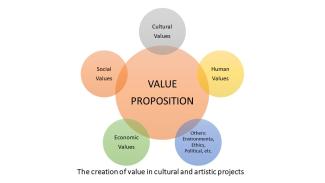
The value propositions of the cultural sectors are rooted in principles and 'values' specific to culture and the arts. These are the main factors that differentiate them from other productive, social and industrial sectors.
The value proposition of a cultural organisation, an artist or a collective integrates a set of 'values' for which different actors and entities decide to purchase its productions and services. The value proposition and the values are different concepts, although they are related and need to be taken into account in the development of projects. In the cultural sectors, the value proposition is a promise that the creator, producer or promoter of culture makes to the user, consumer or funder of a future benefit that he/she will receive if he/she buys or facilitates the development of a particular project.
Values, on the other hand, refer to the benefits or needs that cultural projects provide to the people or entities to whom they are addressed. In other words, they are the values provided by cultural projects for which citizens are willing to acquire and use them.
THE CULTURAL OR INTRINSIC VALUES OF THE ARTS
Values can be of many kinds. However, the ones that should never be absent from artistic production are cultural and artistic values. Including cultural values in the value proposition gives it a differentiating factor from other products that do not have these qualities.
Cultural organisations, and more generally any cultural producer or mediator, need to be very careful in defining their value proposition. Cultural and artistic values must be at the heart of projects. If a product or service lacks these, it may be considered to have the capacity to provide some kind of value and meet some kind of need, but it definitely cannot be considered a cultural production or service. For example, as a cultural value, an artistic work may offer alternative visions of reality, enrich it, develop imagination and critical thinking. Its value proposition will use these characteristics to convince the exhibition curator, the gallery director or the final buyer that the work will reveal all these values at the moment of its contemplation.
So what distinguishes a cultural product from any other kind of product is the ability to create and deliver cultural values. For example, cultural values are the ability to move, to reflect, to connect with one's inner self, to develop critical thinking, and so many others that depend on the subjective experience of people in the arts. A book, a piece of music, a choreography, a gallery, excite, provoke the imagination, make us think, show new aesthetic visions, other critical possibilities of reality, etc. The value proposition of books, music, dance performances or galleries will be the promise that these values will be acquired by reading, listening or looking at them.
OTHER VALUES OF THE ARTISTIC PROJECTS
But cultural products can also provide other kinds of benefits and meet other needs. In addition to providing benefits and satisfying needs based on cultural values, cultural production has the capacity to provide other types of benefits based on other values. In this sense, its richness is broadened and the possibilities for its acquisition by people or organisations are greatly multiplied.
The value propositions of cultural production are also linked to economic values. Cultural production can generate economic income for creators, cultural workers, companies and organisations. It is a necessary condition for the survival of artistic production, which would in many cases disappear if it could not be supported to continue producing. The values related to economic profit are inherent to all types of commercial activity, so although they are necessary for the sustainability of projects, they cannot be considered a differentiating factor with respect to other products or services.
Social values are also often associated with cultural production. Cultural projects can aim to develop and strengthen the links between social communities, both internally and in their diversity. Cultural projects that promote social inclusion, diversity or seek to open up ways to reduce inequalities and injustices create social value.
Cultural projects that provide human values are those that strengthen the development of human beings. Thus, education, care and healing can be included in this group of values. But also entertainment, recreation or well-earned leisure.
Other types of values that are common in cultural production are environmental, political, ethical, etc.
Thus, a product, service, activity or project produced by the creative sectors and cultural industries can be considered cultural or artistic if it provides value to people or entities based on the intrinsic values of culture. In addition, they are likely to provide other types of value. Together they will make it attractive to users and potential clients and therefore capable of being purchased by them.
